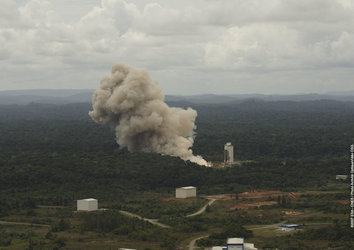Successful first test for Vega’s Zefiro 9-A solid-fuel rocket motor
Yesterday, the
The
After a nominal
Improved design
This improved version of the Z9, with its new nozzle design and an optimised propellant loading, is fully flight-representative of the Vega third-stage motor – the only exception being the use of a truncated nozzle in order to partially adapt the motor to sea-level conditions.

The
Some 400 sensors fitted to the motor allowed monitoring of its behaviour during and after the firing test. The data collected will enable engineers from ELV SpA (Italy), the Vega launch vehicle prime contractor, and Avio SpA (Italy), in charge of the motor development and qualification, to check its performance, in particular:
- ballistic performance (pressure and thrust curves)
- internal thermal-protection efficiency
- thrust-vector control performance
- induced thermal and dynamic environment
Following the test firing, the motor will be shipped back to Colleferro, for detailed inspection.
Towards flight qualification
A second qualification test for the Zefiro 9-A is planned for February 2009. This will complete the qualification process of the Vega solid rocket motors. The P80 first-stage motor and the Z23 second-stage motor, both of which also use solid propellant, have already completed successful qualification firing tests.
The Vega launcher qualification flight is scheduled to take place before the end of 2009, from Europe’s spaceport at Kourou, in French Guiana.
Vega is a single-body launcher composed of three solid-propellant stages and a liquid-propellant upper module. It is approximately 30 m high, and weighs a total of 137 tonnes at lift-off. The reference mission for Vega’s launch capacity is to carry 1500 kg into a 700km-altitude polar orbit, but Vega will be able to launch a wide range of scientific and Earth-observation missions.















 Germany
Germany
 Austria
Austria
 Belgium
Belgium
 Denmark
Denmark
 Spain
Spain
 Estonia
Estonia
 Finland
Finland
 France
France
 Greece
Greece
 Hungary
Hungary
 Ireland
Ireland
 Italy
Italy
 Luxembourg
Luxembourg
 Norway
Norway
 The Netherlands
The Netherlands
 Poland
Poland
 Portugal
Portugal
 Czechia
Czechia
 Romania
Romania
 United Kingdom
United Kingdom
 Slovenia
Slovenia
 Sweden
Sweden
 Switzerland
Switzerland































